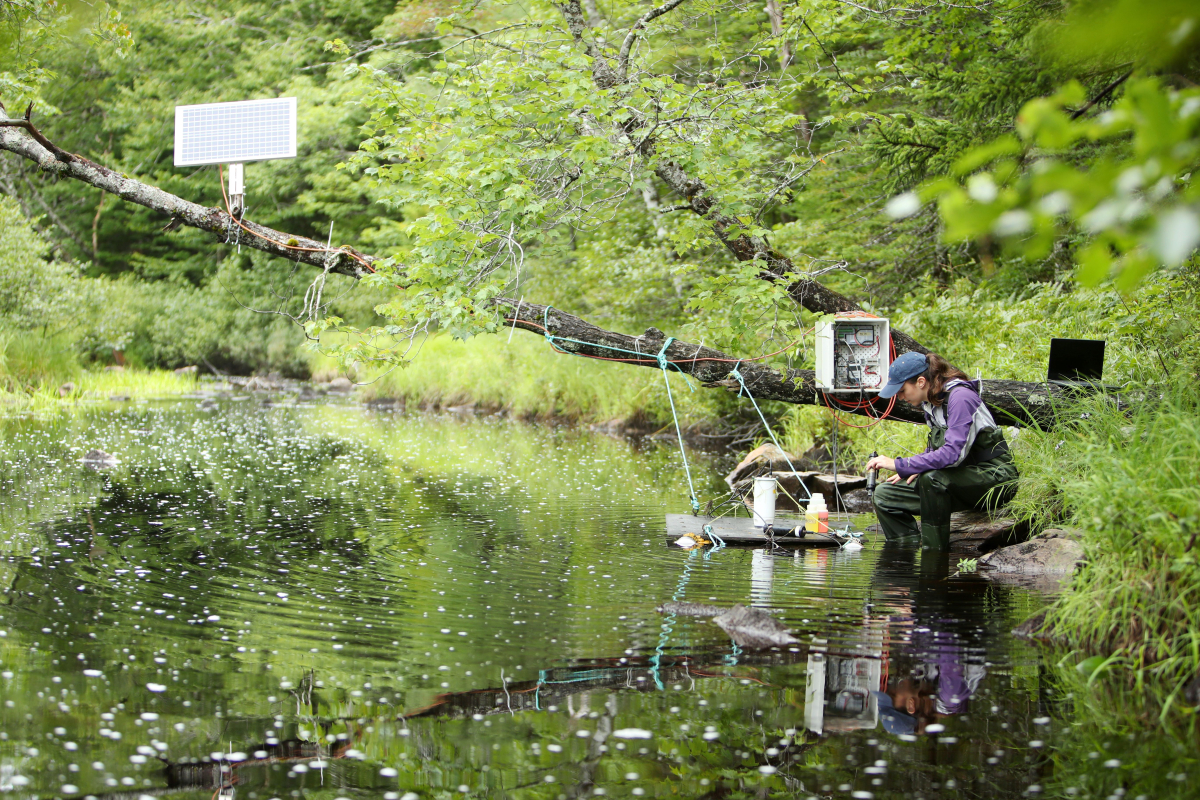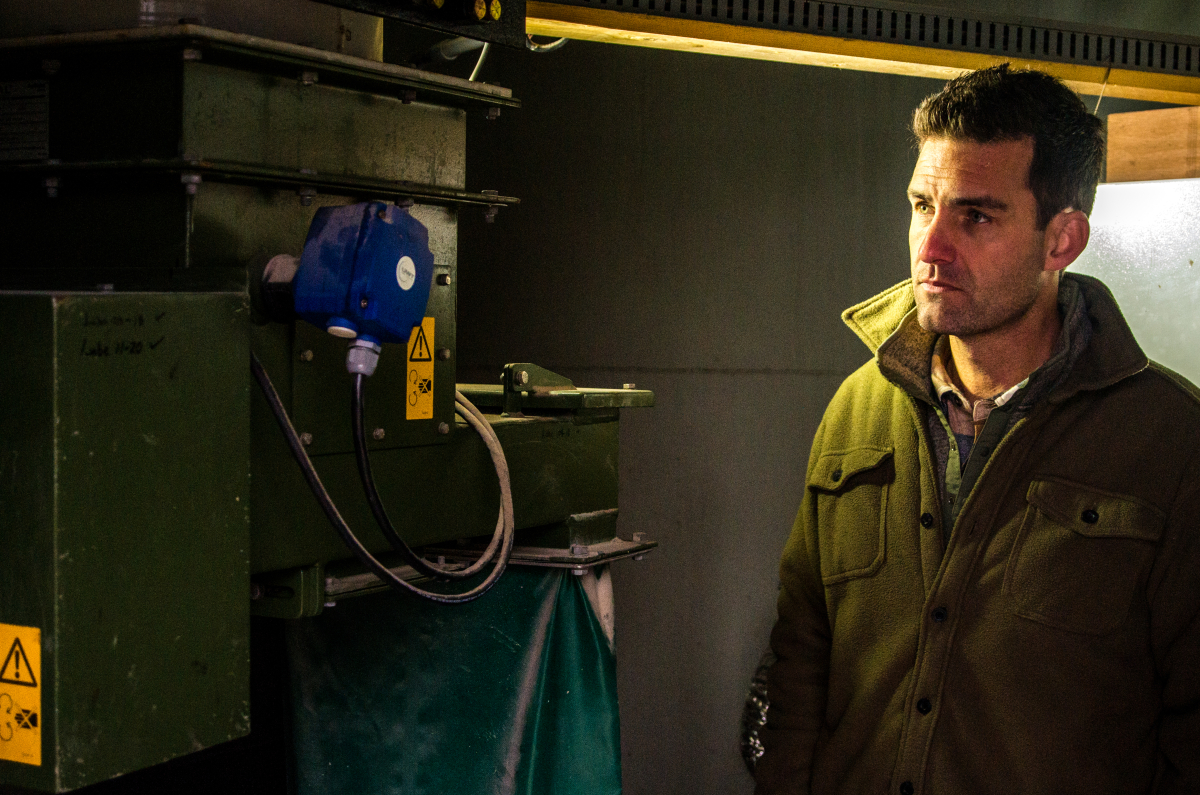Support strong Canadian climate journalism for 2025
Dr. Shannon Sterling, an associate professor of earth and environmental sciences at Dalhousie University, and Dr. Eddie Halfyard, a fresh water ecologist, were going about business as usual when a surprise discovery made them stop in their researcher tracks.
Halfyard, who has spent most of his career helping to find science-based solutions to the challenges facing recreational fisheries that produce salmon, striped bass, and trout with respect to conservation, has also been focused on the negative impacts of acid rain on waterways and those same fisheries.
Research into how to save fish stocks in increasingly acidic rivers led him, in 2005, to be involved with the first limestone dosing project in North America to improve the water quality by increasing alkalinity.
Sterling, who joined Dalhousie University in 2009, was motivated to dig a little deeper into the health of some of the province’s rivers after discovering the plummeting fish numbers in the four which were being monitored.
“The culprit was acid rain,” says Halfyard.
It was his impressive work around the impact of acid rain on salmon stocks, while working with the NS Salmon Association, that led Sterling to contact Halfyard, and eventually begin working with him to further investigate the issue.
“When dissolving the powdered limestone (dosing) into rivers — to balance acidity levels and reintroduce important minerals like calcium and magnesium — we noticed carbon dioxide (CO2) was being consumed as it dissolved,” says Sterling.
Water absorbs CO2, so the ability to “consume” that CO2 while also creating healthier rivers was an exciting prospect for the two researchers — and something they knew had huge implications in terms of the larger fight against climate change.

“Carbon combines with limestone to create bicarbonate, some of which is used by aquatic species for shells, with the rest getting transported to the ocean for storage for thousands of years,” says Halfyard. “So that discovery was a lightbulb going off, and we realized this was big in terms of carbon markets and an integral part of how we get to net zero.”
Both Sterling and Halfyard say that as exciting as the possibilities around this discovery are for the province and beyond, it’s generally been misunderstood by media who’ve contacted them.
“This is not meant to replace decarbonization. This is meant to aid us in meeting our targets to decarbonize,” Sterling says. “And as all of this came together, we absolutely saw [the creation of] a company as the best way forward.”
And so CarbonRun was born, with Sterling acting as both chief scientific officer (CSO) and chief operating officer (COO), while co-founder Halfyard acts as chief technology officer (CTO) and Luke Connell, from the Omega Foundation, serves as chief executive officer (CEO).
After a leading climate solutions expert from Sheffield, England directed Connell to Sterling and Halfyard’s work, the Sterling lab at Dalhousie University became the lucky recipient of a donation from the Omega family foundation and another donor. The foundation, typically focused on poverty relief, realized that climate issues would disproportionately impact disadvantaged people, so looked to make a move into funding climate change projects.
And in terms of river dosing for the recreational salmon fishery — something which has been successfully done in Scandinavia for the last 50 years — the NS Salmon Association, says Halfyard, has been operating dosers in Sheet Harbour since 2005, allowing Sterling and Halfyard to test CO2 hypotheses on those projects with impressive results in terms of both river and fish health.
“In Nova Scotia, rivers that were on the brink have been brought back to health through this process and fish populations, including Atlantic salmon, have also increased,” says Halfyard.
CarbonRun’s first official dosing operation — for carbon removal, and separate from the NS Salmon Association — is about to launch in West River, Pictou, and will be an impressive first in the world of CO2 removal operations.
“This will be the world’s first carbon dosing system,” says Halfyard.
The doser, which will run autonomously, 24 hours a day, will constantly be adding ground limestone as needed, with sensors controlling and administering based on water flow; all of which will be remotely communicated through computer and cell phone, recording data as it goes.
And investments, Sterling says, are now coming from leading carbon credit buyers outside the country, which though on its face might seem unusual, is actually a win — not only for CarbonRun, but for the province itself.
“It’s great for Nova Scotia, as it’s not a question of choosing between funding schools or salmon restoration,” she says. “This way the carbon credit market provides the necessary funding.”
The majority of that outside funding, Sterling says, comes in the form of purchases facilitated by Frontier Climate, a buyers group with over $1B to purchase high quality carbon dioxide removal (CDR) credits from leading CDR companies. The group includes Stripe, Shopify, Alphabet, JP Morgan Chase, and other corporations looking for credible, promising companies that can deliver responsible CO2 removal at potentially meaningful scale.
“They’re funding our Pictou project, the expensive part of the operation like equipment,” says Halfyard.
What this might mean in real terms for rivers and communities throughout Eastern Canada — and eventually beyond — is the ability to tap into the world of carbon credits, which means a cost-free option for towns looking to not only clean up their rivers, but to also aid in the fight against climate change.
“What’s exciting about what CarbonRun has been developing is that there’s zero cost to communities,” says Halfyard. “It’s also a whole new way for out-of-country money to support restoration here in Nova Scotia.”
The irony that the majority of CarbonRun’s funding comes from south of the border is not lost on Sterling and Halfyard.
“The serendipity of it all is that a lot of it is American money, and the U.S. was the main source of all the acid rain pollution in the first place, as well as fossil fuel burning.”
The Climate Story Network is an initiative of Climate Focus, a non-profit organization dedicated to covering stories about community-driven climate solutions.


Comments
Love that it is Canadian. Please be sure to follow up on the results and progress of this exciting project!
So many people pooh pooh the "eggheads" in science and deride scientific exploration; that I want to crow like a triumphant rooster when news like this hits the media. Really, simple dual purpose scientific solutions. low cost, low maintenance, "natural" - what more could you want? Certainly beats the tar out of fossil fuel carbon capture - which is not even viable at this point! Just another scam soaking up tax dollars.
I truly don't like raining on a parade; the problem is that everyone is leading a parade these days; CNO is over-eager to be a mere giggly cheerleader.
So, one resource (limestone) will be mined and consumed to mitigate acidity in fresh water to benefit the ecosystem. On the surface, pun intended, that's great. What makes this article no more than a news release, as so often happens at CNO, is that there is no analysis.
For example, what size rivers (e.g. flow rates) in NS have been treated to-date? Were they the size of, say, any of the sizeable fish-bearing rivers of the West Coast or were they minor streams akin to, say, the Brunette River flowing through Burnaby, New Westminster and Coquitlam in BC? Of course the specific answer to this next question will depend, at least, on the pH level, but how much limestone is required, to pick one relationship, per cubic metre of water? Or per fish, if you like (though an ecosystem is, of course, much more than any single species)?
Though I haven't heard that limestone is a rare mineral, we nonetheless need to add its extraction and depletion, and the impacts of same, to the grand equation of a full lifecycle analysis. I would have appreciated a minimal amount of investigation to such questions in the context of a couple of sizeable, acidifed, east coast rivers.
General suggestion to CNO: how about quality over quantity? An example of that: the Narwhal.